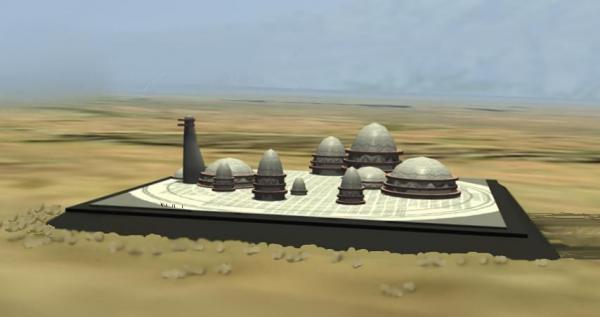BY LETTER
Scrub Slug
Technology > Application > Infrastructure
Technology > Application > Transportation > Surface Transport
Technology > Application > Weapons > Surface Weapons
Technology > Application > Transportation > Surface Transport
Technology > Application > Weapons > Surface Weapons
Very large footed ground vehicles | |
 Image from Steve Bowers | |
| Scrub slugs can be as large as a city; this technology is also used in peacetime to allow urban migration | |
The term "scrub slug" is military slang for a class of large, "footed" ground vehicles (usually vechidai), deriving from a more archaic reference to a class of scavenger vehicle that used this form of locomotion. The evolution and deployment of these vehicles follows some important trends in modern ground-based warfare, and so are ripe areas for historical study. Slug-foot technology is also used in civilian applications to move buildings, houses and even entire cities for various reasons.
Scrub slugs generally consist of automated systems, weapons and/or other infrastructure piled onto a tread or "foot" made from specialised utility fog known as a nanite drive train that offers these hulking beasts a great deal of smooth mobility over even the roughest of terrain. Two forms of locomotion may be used by vehicles with nanite drive trains; the Cascade Drive, which uses a form of wave action, and the Lariat Drive which uses tentacles or pseudopodia of nanites to pull itself forward on its nanite skirt.
Like their living namesake, almost nothing permanently gets in the way of a scrub slug. They can find their way over even the most severe of natural obstacles, and if what they cannot climb over or go around, they can normally consume using their disassembler suites. For this reason, occasionally, scrub slugs have been used as trailblazers for less able vehicles.
Military Use
Modern scrub slugs might actually be better referred to as "land carriers" or "mobile bases" than the scavenger vehicles they inherit their name from. The original scrub slugs tended to be slow, small, noncombatant vehicles, whose sole purpose was to stroll a battlefield after the battle had moved on, collecting the wreckage of broken down war machines and recycling these on-site into working weapons.As scrub slugs were never designed for actual combat operations, their relative bulk and slow speed of movement were never considered much of an issue. Gradually, more and more hardware was piled onto larger, more capable "feet," resulting ultimately in behemoths whose purpose was not only to scour battlefields for recyclable refuse, but also to act as a refueling and repair depot, a command and control relay point, a launch point for short-range aircraft and missile systems ... and ultimately a moving military base, much like the aircraft carriers of early planetary age navies, only not restricted to movement at sea alone.
Placing stationary military assets on the backs of scrub-slugs has conferred a few important military advantages to these otherwise sitting-duck installations. Though slow, scrub slugs can move. Even a city-sized scrub slug can travel quickly enough (up to several kilometers per hour) to move the assets on its back out of the guaranteed kill zone of long range orbital bombardment platforms, provided sufficient notice is obtained. These vehicles also offer advantages in that bases of operation can be moved into captured territory with relative ease, all at once, without the necessary tear-down and set-up periods that can expose critical assets to attack.
Modern scrub-slugs are primarily defensive/command platforms. These can range in size from that of a large truck to that of a small city. Massive system redundancy and dedicated defensive weaponry make them difficult targets for air defenses, and when faced with orbital bombardment, scrub slugs can either attempt to keep moving and evade enemy fire, or "dig in" and bury themselves and their attendant assets to avoid RKKS fire.
It should be noted that, though often laden with defensive weaponry, scrub slugs are woefully vulnerable on their own. (As are many military units, when taken separately from supporting units.) They are entirely unsuited to offensive operations -- a fact that has conferred a secondary meaning to their name. Nevertheless, they represent a truly notable advancement in military technology, uprooting the passive, stationary installation of the past and turning them into dynamic members of the modern surface army.
Civilian Use
Nanite drive-train technology can be used to allow a building or collection of buildings to move across the surface of a planet or megastructure with relative ease. Since the ComEmp period a number of worlds have used slug-foot technology to allow their towns and cities to become mobile. Wandering cities on Zhang Qian, formed from fleets of scrub-slug platforms linked together by temporary roadways, trace elaborate pathways across that dry planet.Related Articles
Appears in Topics
Development Notes
Text by David Jackson
Some additions by Steve Bowers
Initially published on 07 October 2004.
Some additions by Steve Bowers
Initially published on 07 October 2004.






